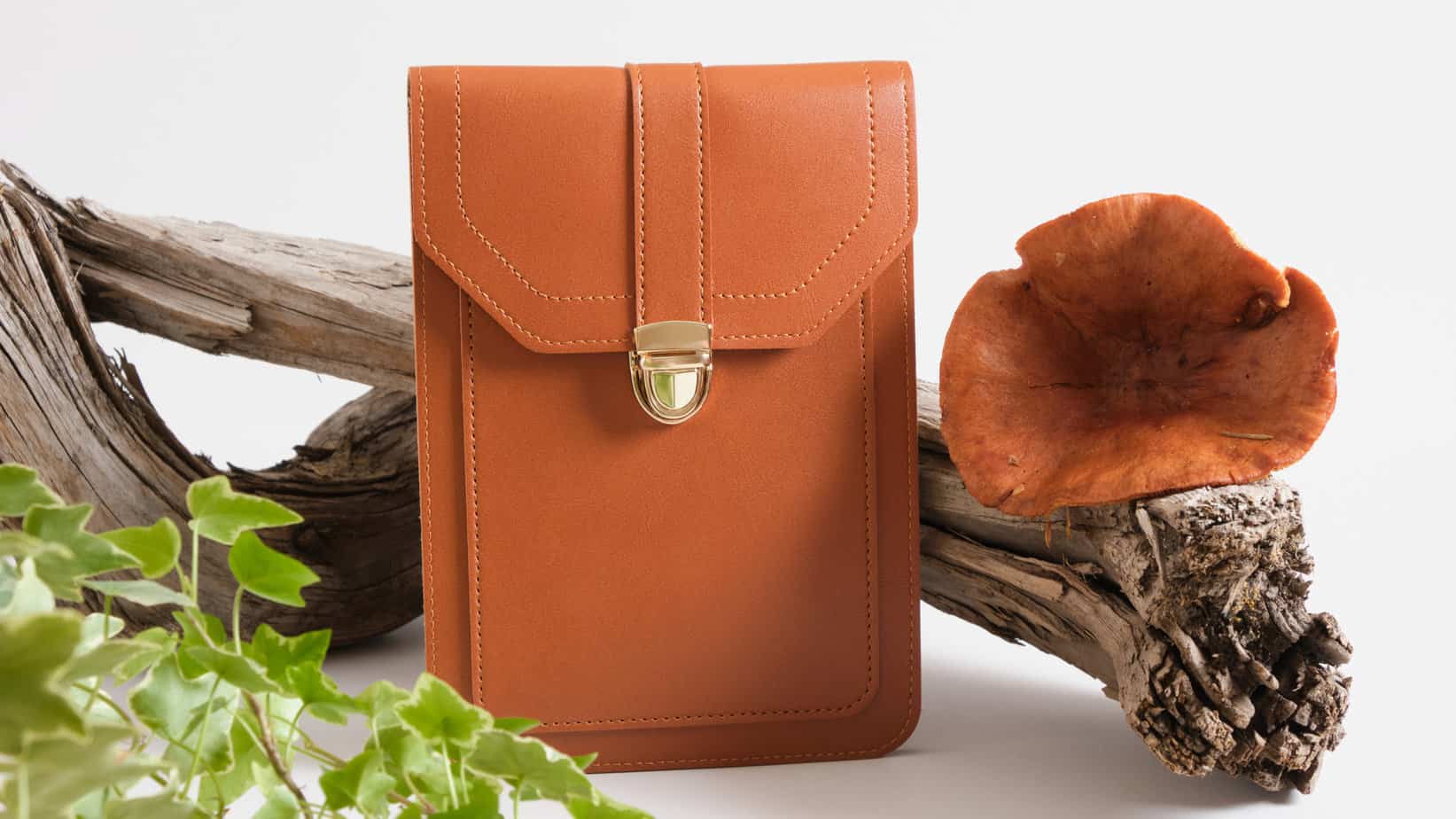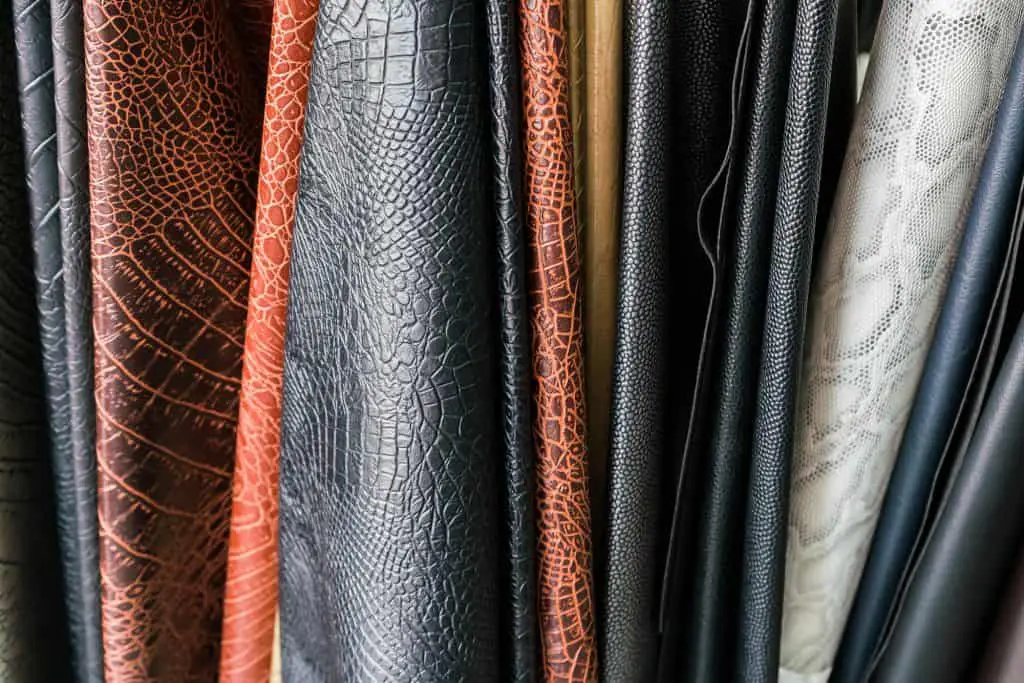Exactly what is “Vegan Leather?” Sounds like a contradiction in terms, and of course, in real life it is. It’s largely a marketing term that sounds better than “plastic”, or “a weird substance we made out of mushrooms”. Nevertheless, it’s more popular than ever, so let’s dig in to what this is, can you make good wallets from it, and should you consider this as a real option for your next wallet?

What is Vegan Leather?
Simply put, “Vegan” leather is an artificial product designed and manufactured to resemble (more or less) real leather. There are two main reasons for this:
- Cost. Real leather is expensive. There will always be a market for goods that look like the real thing, but don’t require a mortgage to obtain them.
- Ethics. Real leather of course, is an animal bi-product. No matter if the animal was killed humanely, or if the leather was purely a side effect of producing animals for food, thats not an option for some.
Why Not Choose a Different Material?
There are a lot of different options these days for wallet materials. You can get a cool wallet made from metal, carbon fiber, wood, … the options are endless. So why choose a faux leather option? It’s simple really. We’re part of nature ourselves, so we’re hard-wired to appreciate the look and feel of natural products. Think about the Impossible Burger – they obviously concluded the best way to get people to eat non-meat food was to … make it look and taste as much like meat as possible.
Real leather just feels better, looks better, even smells better (so long as you’re choosing a good grade of leather that is).
What Is Vegan Leather Made From?
Until a few years ago, there were two main options, PU Leather and PVC.
- PU Leather. PU stands for polyurethane. Typically, this is not the whole story. PU Leather is often made from some other substance (cotton, polyester, genuine but low-quality leather) that is then given a polyurethane coating to make it look glossier and preserve it. Clearly, this can be vegan or not vegan depending on what the underlying material is
- PVC. This stands for Polyvinyl Chloride and is often just called vinyl. Actually, you see that term now mostly used by hipsters buying records, not people buying faux leather goods as it developed a reputation for being cheap and nasty stuff.
Both of these materials also sometimes get referred to as “pleather” (as in, “plastic leather”). In both of these cases you’re talking about the use of complex and sometimes harsh chemicals. Not surprisingly, a lot of people were not happy with this and wanted something more natural (even the surface texture of these materials comes from a roller…)
Enter the Green Faux Leathers
In the last few years, responding to a growing desire for more naturally and ethical-sourced goods, a few companies have begun creating leather-like products from a variety of sources. In most cases, they’ve taken the same general approach as the PU and PVC “leathers” in that they have an industrialized process that produces something that has a reasonable texture and feel to it. This product is then typically adhered to a fabric backing to give it strength and flexibility. Some recent examples:
- Cork Leather. Made from the bark of the cork oak tree (boiled, flattened, adhered to a fabric) this material has the advantage that the cork bark can be harvested in a sustainable way that doesn’t harm the tree (source)
- Pineapple Leather. Made by extracting, soaking, then felting the long fibers in the pineapple plant leaves. This may have been inspired by a traditional Philippine textile called Piña (source)
- Apple Leather. Made by pulverizing the skins, stalks, and leaves of apples, then merging with a polyurethane resin. The beauty of this product is that it uses the parts of the fruit that were previously thrown away in the production of jams and compotes (source)
- Cactus Leather. Made by removing leaves from a mature cactus plant (without killing the plant), mashing, drying, and mixing with other resin-like substances (source)
- Mushroom Leather. Made from the mycelium cells that form the structure of the mushrooms, this is typically made with compression techniques (source)
- And many more are being developed all the time

Is Faux Leather Actually Good For The Environment?
Well now, that’s an interesting question. A lot of people make the assumption that “vegan” = “more natural, so good for the environment”. Marketing departments are probably a big part of this as its a great selling point. It’s not always true however.
The harsh chemicals used in the production of PVC for instance, are not healthy for people working with them or the environment, and even many of the natural-sounding fake leathers might cause more harm than good depending on the growing and manufacturing process. It’s worth looking at a company’s sustainability practices, not just the materials they use.
Buyers Guide – Should You Buy A Vegan Leather Wallet?
This is, as always, a very personal decision. It really comes down to why you’re thinking about this.
Check that you are actually buying vegan leather, not just faux leather.
If the main driver for you is that you want to ensure no animals were harmed in the manufacturing, then this is a perfectly viable approach. But be warned. Some PU leather for instance, is applied to a backing of inexpensive but genuine leather. Always look for an explicit statement that a product is vegan.
If you are looking at this from an environmental impact perspective, then you can’t simply assume that vegan = good for the environment. Always research the company to see how sustainable their approach is
Other things to consider are that faux leathers tend not to be as breathable, and do not develop that true leather patina over time. The breathability aspect is probably not an issue for a wallet (more for a jacket, say) but the patina is something we love in a genuine, preferably handmade, leather wallet.
Your mileage may vary, but for our money – we would go a different way and pick a great metal wallet, or one made from carbon fiber, rather than something that pretends to be something else. You should always be true to yourself, why should your wallet be any different?
All product names, logos, brands, and trademarks are the property of their respective owners

